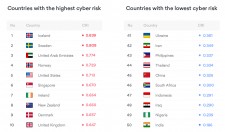
The US Ranks Fifth Amongst the 50 Analyzed Countries With the Index of 0.713
LONDON, May 28, 2020 (Newswire.com) - Residents of developed countries are more likely to become victims of cybercrime, according to the new Cyber Risk Index by NordVPN. The defining qualities of developed countries — high-income economy, advanced technological infrastructure, urbanization, and digitalization — are the same factors that increase the prevalence of cybercrime.
NordVPN’s Cyber Risk Index covers 50 countries comprising 70% of the world population.
The most dangerous place to be online
Northern Europe is the most dangerous region when it comes to cyber risk, while North America is a close second. In both regions, more than 9 out of 10 people use the internet, 8 out of 10 shop online, and 7 out of 10 use Facebook. This leads to increased exposure to cyber threats.
The average monthly wages in Northern Europe and North America are among the highest in the world. “As income increases, it’s only natural to enjoy the comfort of online shopping and other paid services. But that makes people much more enticing targets for cybercriminals,” says Daniel Markuson, a digital privacy expert at NordVPN.
India is the safest. Or is it?
In India, only a third of the population uses the internet, and less than a quarter have smartphones. A tiny share of all Indians use Instagram (5.8%), watch video on demand (7.1%), or play online games (6.6%). The monthly wage in India is 13 times lower than the average of the 50 countries analyzed. That makes India the safest country covered by NordVPN’s Cyber Risk Index. But there are some important caveats.
“Cyber Risk Index reflects the big picture, the country-wide statistics,” says Daniel Markuson. “Indians who do use the internet, spend a lot of time online — more than an hour longer than the average. They probably live in cities and get higher wages. That puts them at a much higher cyber risk than the average Indian.”
In countries with huge income inequality, low levels of urbanization, or low internet penetration, a small segment of the population may face a much larger cyber risk than the general population.
The method behind the Cyber Risk Index
NordVPN created the Index in partnership with Statista, the world’s leading business data provider. The Index was created in three stages. First, Statista collected socio-economic, digital, cyber, and crime data from 50 selected countries. Second, NordVPN analyzed the data’s positive and negative impact on cyber risk and calculated the correlation between the first three data sets (socio-economic, digital, cyber) and the fourth (crime).
Finally, NordVPN trimmed the data down to the 14 most significant factors, used them to create the Index, and ranked the 50 countries according to the cyber risk they’re facing.
More information and a full report: https://nordvpn.com/cri.
Source: NordVPN
Share: